By Alejandro Miranda-Sousa, MD and Kailen Gonzalez, PA-C


Some risk factors for overactive bladder include obesity, caffeine, and constipation. Poorly controlled diabetes, poor functional mobility, and chronic pelvic pain may worsen the symptoms. This condition is more common in women, especially when associated with loss of bladder control but it can also occur in men.
The cause of overactive bladder (OAB) is unclear, and multiple causes are associated with this condition. It is often associated with overactivity of the detrusor muscle. It is also possible that the increased contractile nature originates from within the urothelium (the lining of the bladder wall) and lamina propria (also part of the lining) and abnormal contractions in this tissue. Overactive bladder can be categorized into two different variants: “wet” (i.e., an urgent need to urinate with involuntary leakage) or “dry” (i.e., an urgent need to urinate but no involuntary leakage). Wet OAB is more common than dry.
The diagnosis of OAB can be made clinically with a full history from the patient, a bladder voiding diary and urodynamics. Cystoscopy can also aid in the diagnosis to rule other abnormalities of the bladder. Additionally, a urine culture may be done to rule out infection which can sometime mimic or increase symptoms of OAB.
Treatment for OAB can start with lifestyle modifications such as fluid restriction, avoidance of caffeine and other bladder irritants, and pelvic floor muscle exercise and physical therapy. Biofeedback is used to reduce the frequency of accidents resulting from poor bladder control. This method is aimed at improving the person’s control over the time, place and frequency of urination.
Several anticholinergic medications are frequently used to treat overactive bladder. β3 adrenergic receptor agonists (e.g., mirabegron), may be used, as well. Within the appropriate setting, both anticholinergic drugs and β3 adrenergic receptor agonists may be used in combination to improve symptoms of OAB. PTNS (peripheral tibial nerve stimulation), Interstim (sacral nerve stimulation) and Botox (Botulinum toxin A) are also treatment options done when lifestyle modification and oral medication have failed.
Living with OAB can be difficult. For this condition, you’re likely to start by seeing your primary doctor. After your initial appointment, you may be referred to a Urologist. Some things to keep in mind prior to seeing and during your urological evaluation is: keeping a bladder diary for a few days, recording when, how much and what kind of fluids you consume. Tell your doctor how long you’ve had your symptoms and how they affect your day-to-day activities. Note any other symptoms you’re experiencing, particularly those related to your bowel function. Let your doctor know if you have diabetes, have a neurological disease, or have had pelvic surgery or radiation treatments. Make a list of all the medications, vitamins or supplements you take. With appropriate diagnosis and treatment, OAB is a common condition that can be mitigated by various options. Every patient’s clinical course may be different. Overactive bladder is a common condition but luckily, there are several ways to improve the symptoms for better quality of life.
For more information, please visit our website www.UrologyExperts.com or call Urology Experts today at (239) 226-2727 or email info@UrologyExperts.com to schedule your consultation!
NOW OFFERING TELEMEDICINE!
UROLOGY EXPERTS
239.226.ASAP (2727)
www.UrologyExperts.com
Fort Myers
4571 Colonial Blvd
Suite 110
Fort Myers, FL 33966
Bonita Springs/Estero
3501 Health Center Blvd.
Suite 2420
Bonita Springs, FL 34135
Cape Coral
1206 Country Club Blvd
Cape Coral, FL 33991
 Southwest Florida's Health and Wellness Magazine Health and Wellness Articles
Southwest Florida's Health and Wellness Magazine Health and Wellness Articles

